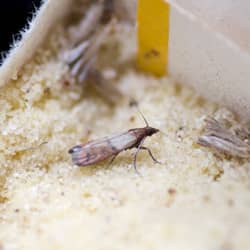Indian meal moths are quite small, measuring only about 3/8 inch in length. Their wingspan is between ½ to ¾ inch. The Indian meal moth has a unique color pattern that helps with identification. The front wings are bi-colored, ranging from a light beige color to a darker, copper or bronze color with a set of pale gray back wings.
The Indian meal moth is one of the more common pantry pests found in kitchens, food warehouses, food processing plants and restaurants. Larvae of the Indian meal moth feed on most stored foods, including grains and grain products, nuts, dried fruit, cereal, herbs, spices, rice, pasta and breads. Other less common areas in which they can be found includes chocolate, cookies and dried flowers. The very wide variety of foods appealing to the Indian meal moth is why it is the most common and most dreaded of all pantry pests.
The adult, when flying, seems to follow a zigzag pattern rather than a straight line. They are sometimes seen flying in areas away from the sources of food and infestation. This sometimes causes them to be mistaken for clothing pests. The habit of wandering away from sources of food can be attributed to the fact that the adult does not eat. The larvae are surface feeders of stored foods and will cover the source of food with a webbing material. In heavy infestations, the larvae spin huge amounts of silken webbing. Feces and shed skins can be found inside this silk covering. This causes an obvious contamination of the food and creates a greater waste than the actual amount of food consumed by the insects.
Cleanliness of cupboards, cabinets and pantries is essential in eliminating the risk of infestation. All surfaces should be kept clean and periodically washed down with soap and water. The larvae will leave the source of food and enter the pupae stage as they transform into adulthood. All cracks in walls and ceilings should be inspected for larvae or pupae.
Inspect stored food packages regularly, paying close attention to items that are rarely used and have remained in storage for long periods of time. Loosely wrapped products or products with very thin wrapping can be a great invitation to Indian meal moths. Transfer all stored food products into sealed containers, prior to placing them in storage. Use glass or hard plastic containers with pest-proof lids. Dry pet food is another attraction to Indian meal moths and is often a source of infestation.
Following these helpful hints and maintaining regular inspections will help reduce the risk of infestation.
 1277 Reviews
1277 Reviews


